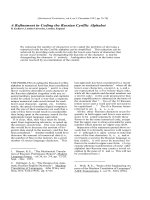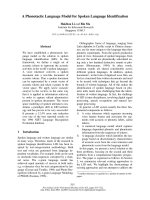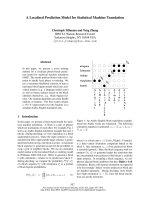Báo cáo khoa học: "A Rose is a Roos is a Ruusu: Querying Translations for Web Image Search" pdf
Bạn đang xem bản rút gọn của tài liệu. Xem và tải ngay bản đầy đủ của tài liệu tại đây (132.79 KB, 4 trang )
Proceedings of the ACL-IJCNLP 2009 Conference Short Papers, pages 193–196,
Suntec, Singapore, 4 August 2009.
c
2009 ACL and AFNLP
A Rose is a Roos is a Ruusu: Querying Translations for Web Image Search
Janara Christensen Mausam Oren Etzioni
Turing Center
Dept. of Computer Science and Engineering
University of Washington, Seattle, WA 98105 USA
{janara, mausam, etzioni} @cs.washington.edu
Abstract
We query Web Image search engines with
words (e.g., spring) but need images that
correspond to particular senses of the word
(e.g., flexible coil). Querying with poly-
semous words often yields unsatisfactory
results from engines such as Google Im-
ages. We build an image search engine,
IDIOM, which improves the quality of re-
turned images by focusing search on the
desired sense. Our algorithm, instead of
searching for the original query, searches
for multiple, automatically chosen trans-
lations of the sense in several languages.
Experimental results show that IDIOM out-
performs Google Images and other com-
peting algorithms returning 22% more rel-
evant images.
1 Introduction
One out of five Web searches is an image search
(Basu, 2009). A large subset of these searches
is subjective in nature, where the user is looking
for different images for a single concept (Linsley,
2009). However, it is a common user experience
that the images returned are not relevant to the in-
tended concept. Typical reasons include (1) exis-
tence of homographs (other words that share the
same spelling, possibly in another language), and
(2) polysemy, several meanings of the query word,
which get merged in the results.
For example, the English word ’spring’ has sev-
eral senses – (1) the season, (2) the water body, (3)
spring coil, and (4) to jump. Ten out of the first fif-
teen Google images for spring relate to the season
sense, three to water body, one to coil and none to
the jumping sense. Simple modifications to query
do not always work. Searching for spring water
results in many images of bottles of spring water
and searching for spring jump returns only three
images (out of fifteen) of someone jumping.
Polysemous words are common in English. It
is estimated that average polysemy of English is
more than 2 and average polysemy of common
English words is much higher (around 4). Thus,
it is not surprising that polysemy presents a signif-
icant limitation in the context of Web Search. This
is especially pronounced for image search where
query modification by adding related words may
not help, since, even though the new words might
be present on the page, they may not be all associ-
ated with an image.
Recently Etzioni et al. (2007) introduced PAN-
IMAGES, a novel approach to image search, which
presents the user with a set of translations. E.g., it
returns 38 translations for the coil sense of spring.
The user can query one or more translations to get
the relevant images. However, this method puts
the onus of choosing a translation on the user. A
typical user is unaware of most properties of lan-
guages and has no idea whether a translation will
make a good query. This results in an added bur-
den on the user to try different translations before
finding the one that returns the relevant images.
Our novel system, IDIOM, removes this addi-
tional burden. Given a desired sense it automati-
cally picks the good translations, searches for as-
sociated images and presents the final images to
the user. For example, it automatically queries the
French ressort when looking for images of spring
coil. We make the following contributions:
• We automatically learn a predictor for "good"
translations to query given a desired sense. A
good translation is one that is monosemous
and is in a major language, i.e., is expected to
yield a large number of images.
• Given a sense we run our predictor on all its
translations to shortlist a set of three transla-
tions to query.
• We evaluate our predictor by comparing the
images that its shortlists return against the
193
images that several competing methods re-
turn. Our evaluation demonstrates that ID-
IOM returns at least one good image for 35%
more senses (than closest competitor) and
overall returns 22% better images.
2 Background
IDIOM makes heavy use of a sense disambiguated,
vastly multilingual dictionary called PANDIC-
TIONARY (Mausam et al., 2009). PANDIC-
TIONARY is automatically constructed by prob-
abilistic inference over a graph of translations,
which is compiled from a large number of multi-
lingual and bilingual dictionaries. For each sense
PANDICTIONARY provides us with a set of trans-
lations in several languages. Since it is gener-
ated by inference, some of the asserted transla-
tions may be incorrect – it additionally associates
a probability score with each translation. For
our work we choose a probability threshold such
that the overall precision of the dictionary is 0.9
(evaluated based on a random sample). PANDIC-
TIONARY has about 80,000 senses and about 1.8
million translations at precision 0.9.
We use Google Image Search as our underlying
image search engine, but our methods are indepen-
dent of the underlying search engine used.
3 The IDIOM Algorithm
At the highest level IDIOM operates in three main
steps: (1) Given a new query q it looks up its vari-
ous senses in PANDICTIONARY. It displays these
senses and asks the user to select the intended
sense, s
q
. (2) It runs Algorithm 1 to shortlist three
translations of s
q
that are expected to return high
quality images. (3) It queries Google Images us-
ing the three shortlisted translations and displays
the images. In this fashion IDIOM searches for
images that are relevant to the intended concept
as opposed to using a possibly ambiguous query.
The key technical component is the second step
– shortlisting the translations. We first use PAN-
DICTIONARY to acquire a set of high probability
translations of s
q
. We run each of these transla-
tions through a learned classifier, which predicts
whether it will make a good query, i.e., whether
we can expect images relevant to this sense if
queried using this translation. The classifier ad-
ditionally outputs a confidence score, which we
use to rank the various translations. We pick the
top three translations, as long as they are above a
minimum confidence score, and return those as the
shortlisted queries. Algorithm 1 describes this as
a pseudo-code.
Algorithm 1 findGoodTranslationsToQuery(s
q
)
1: translations = translations of s
q
in PANDICTIONARY
2: for all w ∈ translations do
3: pd = getPanDictionaryFeatures(w, s
q
)
4: g = getGoogleFeatures(w, s
q
)
5: conf[w] = confidence in Learner.classify(pd, g)
6: sort all words w in decreasing order of conf scores
7: return top three w from the sorted list
3.1 Features for Classifier
What makes a translation w good to query? A
desired translation is one that (1) is in a high-
coverage language, so that the number of images
returned is large, (2) monosemously expresses the
intended sense s
q
, or at least has this sense as
its dominant sense, and (3) does not have homo-
graphs in other languages. Such a translation is
expected to yield images relevant to only the in-
tended sense. We construct several features that
provide us evidence for these desired characteris-
tics. Our features are automatically extracted from
PANDICTIONARY and Google.
For the first criterion we restrict the transla-
tions to a set of high-coverage languages includ-
ing English, French, German, Spanish, Chinese,
Japanese, Arabic, Russian, Korean, Italian, and
Portuguese. Additionally, we include the lan-
guage as well as number of documents returned by
Google search of w as features for the classifier.
To detect if w is monosemous we add a feature
reflecting the degree of polysemy of w: the num-
ber of PANDICTIONARY senses that w belongs to.
The higher this number the more polysemous w
is expected to be. We also include the number of
languages that have w in their vocabulary, thus,
adding a feature for the degree of homography.
PANDICTIONARY is arranged such that each
sense has an English source word. If the source
word is part of many senses but s
q
is much more
popular than others or s
q
is ordered before the
other senses then we can expect s
q
to be the dom-
inant sense for this word. We include features like
size of the sense and order of the sense.
Part of speech of s
q
is another feature. Finally
we also add the probability score that w is a trans-
lation of s
q
in our feature set.
3.2 Training the Classifier
To train our classifier we used Weka (Witten and
Frank, 2005) on a hand labeled dataset of 767 ran-
194
0 100 200 300 400
0.00 0.10 0.20
Number of Good Images Returned
Precision
IDIOM
SW
SW+G
R
SW+R
IDIOM SW SW+G SW+R R
Percentage Correct
0 20 40 60
IDIOM SW SW+G SW+R R
Percentage Correct
0 20 40 60
Figure 1: (a): Precision of images vs. the number of relevant images returned. IDIOM covers the maximum area. (b,c) The
percentage of senses for which at least one relevant result was returned, for (b) all senses and (c) for minor senses of the queries.
domly chosen word sense pairs (e.g., pair of ‘pri-
mavera,’ and ‘the season spring’). We labeled a
pair as positive if googling the word returns at least
one good image for the sense in the top three. We
compared performance among a number of ma-
chine learning algorithms and found that Random
Forests (Breiman, 2001) performed the best over-
all with 69% classification accuracy using ten fold
cross validation versus 63% for Naive Bayes and
62% for SVMs. This high performance of Ran-
dom Forests mirrors other past experiments (Caru-
ana and Niculescu-Mizil, 2006).
Because of the ensemble nature of Random
Forests it is difficult to inspect the learned clas-
sifier for analysis. Still, anecdotal evidence sug-
gests that the classifier is able to learn an effective
model of good translations. We observe that it fa-
vors English whenever the English word is part of
one or few senses – it picks out auction when the
query is ‘sale’ in the sense of “act of putting up
for auction to highest bidder". In cases where En-
glish is more ambiguous it chooses a relatively less
ambiguous word in another language. It chooses
the French word ressort for finding ‘spring’ in the
sense of coil. For the query ‘gift’ we notice that it
does not choose the original query. This matches
our intuition, since gift has many homographs –
the German word ‘Gift’ means poison or venom.
4 Experiments
Can querying translations instead of the original
query improve the quality of image search? If so,
then how much does our classifier help compared
to querying random translations? We also analyze
our results and study the variation of image qual-
ity along various dimensions, like part of speech,
abstractness/concreteness of the sense, and ambi-
guity of the original query.
As a comparison, we are interested in how ID-
IOM performs in relation to other methods for
querying Google Images. We compare IDIOM to
several methods. (1) Source Word (SW): Querying
with only the source word. This comparison func-
tions as our baseline. (2) Source Word + Gloss
(SW+G): Querying with the source word and the
gloss for the sense
1
. This method is one way to fo-
cus the source word towards the desired sense. (3)
Source Word + Random (SW+R): Querying with
three pairs of source word and a random transla-
tion. This is another natural way to extend the
baseline for the intended sense. (4) Random (R):
Querying with three random translations. This
tests the extent to which our classifier improves
our results compared to randomly choosing trans-
lations shown to the user in PANIMAGES.
We randomly select fifty English queries from
PANDICTIONARY and look up all senses contain-
ing these in PANDICTIONARY, resulting in a total
of 134 senses. These queries include short word
sequences (e.g., ‘open sea’), mildly polysemous
queries like ‘pan’ (means Greek God and cooking
vessel) and highly polysemous ones like ‘light’.
For each sense of each word, we query Google
Images with the query terms suggested by each
method and evaluate the top fifteen results. For
methods in which we have three queries, we eval-
uate the top five results for each query. We evalu-
ate a total of fifteen results because Google Images
fits fifteen images on each page for our screen size.
Figure 1(a) compares the precision of the five
methods with the number of good images re-
turned. We vary the number of images in con-
sideration from 1 to 15 to generate various points
in the graph. IDIOM outperforms the others by
wide margins overall producing a larger number of
good images and at higher precision. Surprisingly,
the closest competitor is the baseline method as
opposed to other methods that try to focus the
search towards the intended sense. This is prob-
ably because the additional words in the query (ei-
ther from gloss or a random translation) confuse
Google Images rather than focusing the search.
IDIOM covers 41% more area than SW. Overall
1
PANDICTIONARY provides a gloss (short explanation)
for each sense. E.g., a gloss for ‘hero’ is ‘role model.’
195
1 sense 2 or 3 senses >3 senses
Percentage Correct
0 20 40 60 80
IDIOM
SW
SW+G
SW+R
R
Noun Verb Adjective
Percentage Correct
0 20 40 60 80
IDIOM
SW
SW+G
SW+R
R
Concrete Abstract
Percentage Correct
0 20 40 60 80
IDIOM
SW
SW+G
SW+R
R
Figure 2: The percentage of senses for which at least one relevant result was returned varied along several dimensions: (a)
polysemy of original query, and (b) part of speech of the sense, (c) abstractness/concreteness of the sense.
IDIOM produces 22% better images compared to
SW (389 vs 318).
We also observe that random translations return
much worse images than IDIOM suggesting that a
classifier is essential for high quality images.
Figure 1(b) compares the percentage of senses
for which at least one good result was returned in
the fifteen. Here IDIOM performs the best at 51%.
Each other method performs at about 40%. The re-
sults are statistically highly significant (p < 0.01).
Figure 1(c) compares the performance just on
the subset of the non-dominant senses of the query
words. All methods perform worse than in Figure
1(b) but IDIOM outperforms the others.
We also analyze our results across several di-
mensions. Figure 2(a) compares the performance
as a function of polysemy of the original query. As
expected, the disparity in methods is much more
for high polysemy queries. Most methods perform
well for the easy case of unambiguous queries.
Figure 2(b) compares along the different parts
of speech. For nouns and verbs, IDIOM returns the
best results. For adjectives, IDIOM and SW per-
form the best. Overall, nouns are the easiest for
finding images and we did not find much differ-
ence between verbs and adjectives.
Finally, Figure 2(c) reports how the methods
perform on abstract versus concrete queries. We
define a sense as abstract if it does not have a nat-
ural physical manifestation. For example, we clas-
sify ‘nest’ (a bird built structure) as concrete, and
‘confirm’ (to strengthen) as abstract. IDIOM per-
forms better than the other methods, but the results
vary massively between the two categories.
Overall, we find that our new system consis-
tently produces better results across the several di-
mensions and various metrics.
5 Related Work and Conclusions
Related Work: The popular paradigm for image
search is keyword-based, but it suffers due to pol-
ysemy and homography. An alternative paradigm
is content based (Datta et al., 2008), which is very
slow and works on simpler images. The field
of cross-lingual information retrieval (Ballesteros
and Croft, 1996) often performs translation-based
search. Other than PANIMAGES (which we out-
perform), no one to our knowledge has used this
for image search.
Conclusions: The recent development of PAN-
DICTIONARY (Mausam et al., 2009), a sense-
distinguished, massively multilingual dictionary,
enables a novel image search engine called ID-
IOM. We show that querying unambiguous trans-
lations of a sense produces images for 35% more
concepts compared to querying just the English
source word. In the process we learn a classi-
fier that predicts whether a given translation is a
good query for the intended sense or not. We
plan to release an image search website based
on IDIOM. In the future we wish to incorporate
knowledge from WordNet and cross-lingual links
in Wikipedia to increase IDIOM’s coverage beyond
the senses from PANDICTIONARY.
References
L. Ballesteros and B. Croft. 1996. Dictionary methods for
cross-lingual information retrieval. In DEXA Conference
on Database and Expert Systems Applications.
Dev Basu. 2009. How To Leverage Rich Me-
dia SEO for Small Businesses. In Search En-
gine Journal. -
media-small-business-seo/9580.
L. Breiman. 2001. Random forests. Machine Learning,
45(1):5–32.
R. Caruana and A. Niculescu-Mizil. 2006. An empiri-
cal comparison of supervised learning algorithms. In
ICML’06, pages 161–168.
R. Datta, D. Joshi, J. Li, and J. Wang. 2008. Image retrieval:
Ideas, influences, and trends of the new age. ACM Com-
puting Surveys, 40(2):1–60.
O. Etzioni, K. Reiter, S. Soderland, and M. Sammer. 2007.
Lexical translation with application to image search on the
Web. In Machine Translation Summit XI.
Peter Linsley. 2009. Google Image Search. In SMX West.
Mausam, S. Soderland, O. Etzioni, D. Weld, M. Skinner, and
J. Bilmes. 2009. Compiling a massive, multilingual dic-
tionary via probabilistic inference. In ACL’09.
I. Witten and E. Frank. 2005. Data Mining: Practical Ma-
chine Learning Tools and Techniques. Morgan Kaufmann.
196









